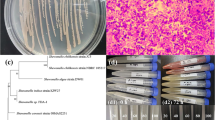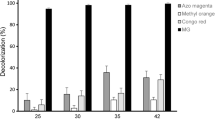Abstract
Biobarriers remove, via precipitation, the metalloid selenite (SeO −23 ) from groundwater; a process that involves the biological reduction of soluble SeO −23 to insoluble elemental red selenium (Se0). The enzymes associated with this reduction process are poorly understood. In Rhizobium selenitireducens at least two enzymes are potentially involved; one, a nitrite reductase reduces SeO −23 to Se0 but another protein may also be involved which is investigated in this study. Proteins from R. selenitireducens cells were precipitated with ammonium sulfate and run on native electrophoresis gels. When these gels were incubated with NADH and SeO −23 a band of precipitated Se0 developed signifying the presence of a SeO −23 reducing protein. Bands were cut from the gel and analyzed for peptides via LCMSMS. The amino acid sequences associated with the bands indicated the presence of an NADH:flavin oxidoreductase that resembles YP_001326930 from Sinorhizobium medicae. The protein is part of a protein family termed old-yellow-enzymes (OYE) that contain a flavin binding domain. OYE enzymes are often involved in protecting cells from oxidative stress and, due in part to an active site that has a highly accessible binding pocket, are generally active on a wide range of substrates. This report is the first of an OYE enzyme being involved in SeO −23 reduction.



Similar content being viewed by others
References
Afkar E, Lisak J, Saltikov C, Basu P, Oremland RS, Stolz JF (2003) The respiratory arsenate reductase from Bacillus selenitireducens strain MLS10. FEMS Microbiol Lett 226:107–112
Basaglia M, Toffanin A, Baldan E, Bottegal M, Shapleigh JP, Casella S (2007) Selenite-reducing capacity of the copper-containing nitrite reductase of Rhizobium sullae. FEMS Microbiol Lett 269:124–130
Bébien M, Kirsch J, Méjean V, Verméglio A (2002) Involvement of a putative molybdenum enzyme in the reduction of selenate by Escherichia coli. Microbiology 148:3865–3872
Chiong M, Gonzales E, Barra R, Vasquez C (1988) Purification and biochemical of tellurite-reducing activities from Thermus thermophilus HB8. J Bacteriol 170:3269–3273
DeMoll-Decker H, Macy JM (1993) The periplasmic nitrite reductase of Thauera selenatis may catalyze the reduction of selenite to elemental selenium. Arch Microbiol 160:241–247
Fitzpatrick TB, Amrhein N, Macheroux P (2003) Characterization of YqjM, an old yellow enzyme homolog from Bacillus subtilis involved in the oxidative stress response. J Biol Chem 278:19891–19897
Fox KM, Karplus A (1994) Old yellow enzyme at 2 Å resolution: overall structure, ligand binding, and comparison with related flavoproteins. Structure 2:1089–1105
Griese JJ, Jakob RP, Schwarzinger S, Dobbek H (2006) Xenobiotic reductase A in the degradation of quinoline by Pseudomonas putida 86: physiological function, structure and mechanism of 8-hydroxycoumarin reduction. J Mol Biol 361:140–152
Hunter WJ (2007) An Azospira oryzae (syn Dechlorosoma suillum) strain that reduces selenate and selenite to elemental red selenium. Curr Microbiol 54:376–381
Hunter WJ, Kuykendall LD (2006) Identification and characterization of an Aeromonas salmonicida (syn Haemophilus piscium) strain that reduces selenite to elemental red selenium. Curr Microbiol 52:305–309
Hunter WJ, Kuykendall LD (2007) Reduction of selenite to elemental red selenium by Rhizobium sp. Strain B1. Curr Microbiol 55:344–349
Hunter WJ, Manter DK (2008) Bio-reduction of selenite to elemental red selenium by Tetrathiobacter kashmirensis. Curr Microbiol 57:83–88
Hunter WJ, Manter DK (2009) Reduction of selenite to elemental red selenium by Pseudomonas sp. strain CA5. Curr Microbiol 58:493–498
Hunter WJ, Kuykendall LD, Manter DK (2007) Rhizobium selenireducens sp. nov.: a selenite-reducing a-Proteobacteria isolated from a bioreactor. Curr Microbiol 55:455–460
Juris SJ, Shah K, Shokat K, Dixon JE, Vacratsis PO (2006) Identification of otubain 1 as a novel substrate for the Yersinia protein kinase using chemical genetics and mass spectrometry. FEBS Lett 580:179–183
Kessi J (2006) Enzymic systems proposed to be involved in the dissimilatory reduction of selenite in the purple non-sulfur bacteria Rhodospirillum rubrum and Rhodobacter capsulatus. Microbiology 152:731–743
Kitzing K, Fitzpatrick TB, Wilken C, Sawa J, Bourenkov GP, Macheroux P, Clausen T (2005) The 1.3 Å crystal structure of the flavoprotein YqjM reveals a novel class of old yellow enzymes. J Biol Chem 280:27904–27913
Lund K, DeMoss JA (1976) Association-dissociation behavior and subunits structure of heat-released nitrate reductase from Escherichia coli. J Biol Chem 251:2207–2213
Massey M, Müller F, Feldberg R, Schuman M, Sullivan PA, Howell LG, Mayhew SG, Matthews G, Foust GP (1969) The reactivity of flavoproteins with sulfite, possible relevance to the problem of oxygen reactivity. J Biol Chem 244:3999–4006
Massey V, Strickland S, Mayhew SG, Howell LG, Engel PC, Matthews RG, Schuman M, Sullivan PA (1969) The production of superoxide anion radicals in the reaction of reduced flavins and flavoproteins with molecular oxygen. Biochem Biophys Res Commun 36:891–897
Opperman DJ, Piater LA, van Heerden E (2008) A novel chromate reductase from Thermus scotoductus SA-01 related to old yellow enzyme. J Bact 190:3076–3082
Pierru B, Grosse S, Pignol D, Sabaty M (2006) Genetic and biochemical evidence for the involvement of a molybdenum-dependent enzyme in one of the selenite reduction pathways of Rhodobacter sphaeroides f. sp. denitrificans IL106. Appl Environ Microbiol 72:3147–3153
Seko Y, Imura N (1997) Active oxygen generation as a possible mechanism of selenium toxicity. Biomed Environ Sci 10:333–339
Spiegelhauer O (2010) Determinants of substrate binding and protonation in the flavoenzyme xenobiotic reductase A. J Mol Biol 403:286–298
Spiegelhauer O, Mende S, Dickert F, Knauer SH, Ullmann GM, Dobbek H (2010) Cysteine as a modulator residue in the active site of xenobiotic reductase A: a structural, thermodynamic and kinetic study. J Mol Biol 398:66–82
Theorell H (1935) Reindarstellung der Wirkungsgruppe des gelben Ferments. Biochemische Zeitschrift 275:344–346
Tomei FA, Barton LL, Lemanski CL, Zocco TG (1962) Reduction of selenate and selenite to elemental selenium by Wolinella succinogenes. Can J Microbiol 38:1328–1333
Turner RJ, Weiner JH, Taylor DE (1998) Selenium metabolism in Escherichia coli. Biometals 11:223–227
Watts CA, Ridley H, Condie KL, Leaver JT, Richardson DJ, Butler CS (2003) Selenate reduction by Enterobacter cloacae SLD1a-1 is catalysed by a molybdenum-dependent membrane-bound enzyme that is distinct from the membrane-bound nitrate reductase. FEMS Microbiol Lett 228:273–279
Williams RE, Rathbone DA, Scrutton NS, Bruce NC (2004) Biotransformation of explosives by the old yellow enzyme Family of flavoproteins. Appl Environ Microbiol 70:3566–3574. doi:10.1128/AEM.70.6.3566-3574.2004
Yanke LJ, Bryant RD, Laishley EJ (1995) Hydrogenase (I) of Clostridium pasteurianum functions a novel selenite reductase. Anaerobe 1:61–67
Acknowledgments
The author thanks Robin Montenieri and Joshua Padilla for their expert technical assistance. Manufacturer and product brand names are given for the reader’s convenience and do not reflect endorsement by the US government. This article was the work of US government employees engaged in their official duties and is exempt from copyright.
Author information
Authors and Affiliations
Corresponding author
Rights and permissions
About this article
Cite this article
Hunter, W.J. A Rhizobium selenitireducens Protein Showing Selenite Reductase Activity. Curr Microbiol 68, 311–316 (2014). https://doi.org/10.1007/s00284-013-0474-7
Received:
Accepted:
Published:
Issue Date:
DOI: https://doi.org/10.1007/s00284-013-0474-7




